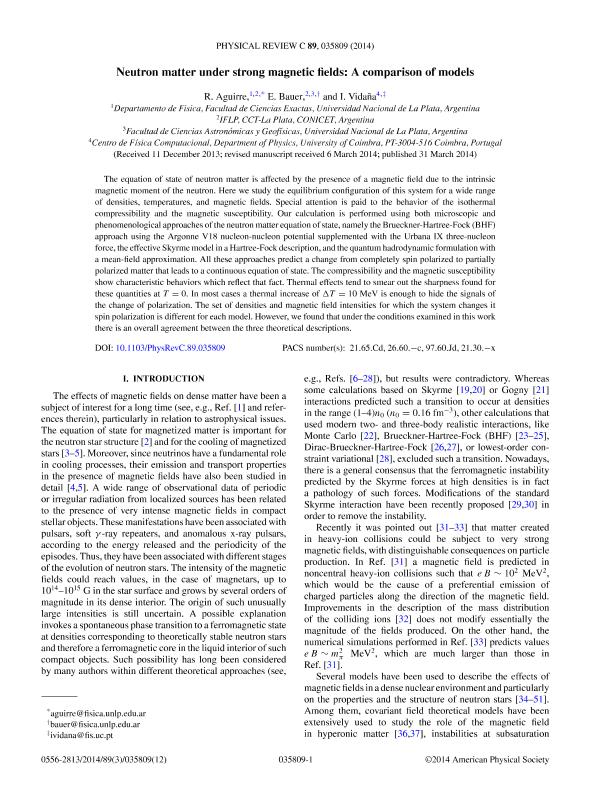Mostrar el registro sencillo del ítem
dc.contributor.author
Aguirre, Ricardo Miguel

dc.contributor.author
Bauer, Eduardo

dc.contributor.author
Vidaña, I.
dc.date.available
2017-09-06T23:37:36Z
dc.date.issued
2014-03
dc.identifier.citation
Aguirre, Ricardo Miguel; Bauer, Eduardo; Vidaña, I.; Neutron matter under strong magnetic fields: A comparison of models; American Physical Society; Physical Review C: Nuclear Physics; 89; 3; 3-2014; 3580901-3580912
dc.identifier.issn
0556-2813
dc.identifier.uri
http://hdl.handle.net/11336/23747
dc.description.abstract
The equation of state of neutron matter is affected by the presence of a magnetic field due to the intrinsic magnetic moment of the neutron. Here we study the equilibrium configuration of this system for a wide range of densities, temperatures, and magnetic fields. Special attention is paid to the behavior of the isothermal compressibility and the magnetic susceptibility. Our calculation is performed using both microscopic and phenomenological approaches of the neutron matter equation of state, namely the Brueckner-Hartree-Fock (BHF) approach using the Argonne V18 nucleon-nucleon potential supplemented with the Urbana IX three-nucleon force, the effective Skyrme model in a Hartree-Fock description, and the quantum hadrodynamic formulation with a mean-field approximation. All these approaches predict a change from completely spin polarized to partially polarized matter that leads to a continuous equation of state. The compressibility and the magnetic susceptibility show characteristic behaviors which reflect that fact. Thermal effects tend to smear out the sharpness found for these quantities at T=0. In most cases a thermal increase of ΔT=10 MeV is enough to hide the signals of the change of polarization. The set of densities and magnetic field intensities for which the system changes it spin polarization is different for each model. However, we found that under the conditions examined in this work there is an overall agreement between the three theoretical descriptions
dc.format
application/pdf
dc.language.iso
eng
dc.publisher
American Physical Society

dc.rights
info:eu-repo/semantics/openAccess
dc.rights.uri
https://creativecommons.org/licenses/by-nc-sa/2.5/ar/
dc.subject
Neutron Matter
dc.subject
Magnetic
dc.subject
Equation of State
dc.subject.classification
Otras Ciencias Físicas

dc.subject.classification
Ciencias Físicas

dc.subject.classification
CIENCIAS NATURALES Y EXACTAS

dc.title
Neutron matter under strong magnetic fields: A comparison of models
dc.type
info:eu-repo/semantics/article
dc.type
info:ar-repo/semantics/artículo
dc.type
info:eu-repo/semantics/publishedVersion
dc.date.updated
2017-09-06T19:31:31Z
dc.journal.volume
89
dc.journal.number
3
dc.journal.pagination
3580901-3580912
dc.journal.pais
Estados Unidos

dc.journal.ciudad
Nueva York
dc.description.fil
Fil: Aguirre, Ricardo Miguel. Universidad Nacional de La Plata. Facultad de Ciencias Exactas. Departamento de Física; Argentina. Consejo Nacional de Investigaciones Científicas y Técnicas. Centro Científico Tecnológico Conicet - La Plata. Instituto de Física La Plata. Universidad Nacional de La Plata. Facultad de Ciencias Exactas. Instituto de Física La Plata; Argentina
dc.description.fil
Fil: Bauer, Eduardo. Universidad Nacional de la Plata. Facultad de Ciencias Astronómicas y Geofísicas; Argentina. Consejo Nacional de Investigaciones Científicas y Técnicas. Centro Científico Tecnológico Conicet - La Plata. Instituto de Física La Plata. Universidad Nacional de La Plata. Facultad de Ciencias Exactas. Instituto de Física La Plata; Argentina
dc.description.fil
Fil: Vidaña, I.. Universidad de Coimbra; Portugal
dc.journal.title
Physical Review C: Nuclear Physics

dc.relation.alternativeid
info:eu-repo/semantics/altIdentifier/doi/http://dx.doi.org/10.1103/PhysRevC.89.035809
dc.relation.alternativeid
info:eu-repo/semantics/altIdentifier/url/https://journals.aps.org/prc/abstract/10.1103/PhysRevC.89.035809
Archivos asociados
